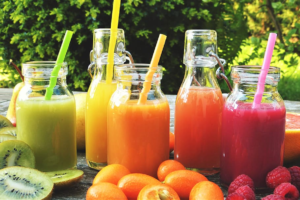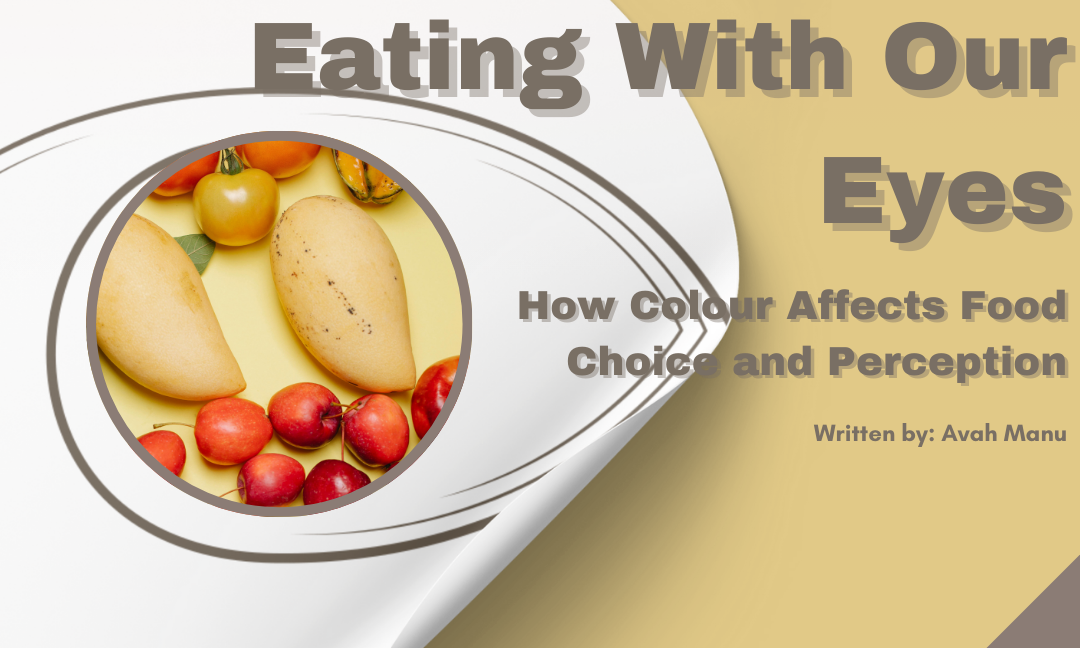Written by: Avah Manu
Edited by: Alishba Khursheed
Designed by: Andria Sahar
Published by: Eleanor Jeavons
If I were to ask you which of the five senses—sight, touch, taste, smell, or hearing—plays the biggest role in our food choices, habits, and preferences, you might instinctively say taste. And while taste is certainly crucial, I would argue that sight is even more influential. Before we can smell, taste, or touch our food, we first see it. Our sight provides key information about a meal, such as its type, texture, flavour, and even nutritional value.

Colour has been shown to have effects on our perception of taste and flavour. Adding green food colouring decreases one’s ability to detect sourness and increases their detection of sweetness. Yellow colouring reduced the detection of both sourness and sweetness and red colouring decreased their perception of bitterness. The results procured from the study exemplify the human mind and its ability to learn from its environment by pattern recognition. During these tests, the participant’s detection of salty flavour was unaffected by the addition of food colouring. Maga J. A., the experimenter, presumed this phenomenon was caused by the fact that salt is associated with foods of many different colours.
Another example of when people’s senses were confounded by colour was during an experiment performed by Lavin and Lawless. Participants were offered two pairs of drinks, the first pair a dark and light red and the second pair a light and dark green. All four solutions had an equal amount of sweetness and strawberry flavour. The light green and dark red drinks were assessed as having a more potent flavour compared to the dark green and light red drinks by adults. From these studies, we can deduce that more intensely coloured foods are associated with more concentrated flavours. Additionally, our minds also create a correlation between bitter foods which are usually green. This explains why they didn’t associate a dark green drink with having a high level of sweetness and a concentrated strawberry flavour.
From birth, our mind subconsciously develops associations between foods and their appearance. This is why brown spots on fruit indicate decay and a green banana tells us it’s unripe. Cultural differences also play a role in colour associations, as demonstrated by a study comparing participants from Taiwan and the UK. Young adults were shown an image of two drinks. One drink contained a red liquid and the other a light blue. When asked what they expected the drink to taste like, the people situated in the UK expected the red liquid to be strawberry/ cherry flavoured and the light-blue liquid to be raspberry. In contrast, participants in Taiwan associated the red liquid with cranberry flavour and the light-blue liquid as mint flavoured. Therefore, we can establish that interpretations of food colours have varying meanings due to cultural and regional differences.
Furthermore, colour psychology plays a significant role in marketing strategies. As we know, certain hues can evoke emotions in an individual. Without discussing its effect on food, it is commonly known that blue is symbolically used to represent serenity and red action. Science has also discovered its influence on taste reception and its ability to puzzle the senses. As a result of these discoveries, marketers use the concepts explored in colour psychology to attract a specific target audience and to elicit certain experiences and ideas within a customer when presenting a product. For example, businesses that sell organic nutrients and whole foods, utilize hues of green and blue to speak to their customers about the healthy and fresh nature of their products. As seen with companies such as Nature Valley, the usage of green in their designs further engages the belief that their items are healthy and use natural ingredients. Individuals searching for nutritious foods and who possess a healthy lifestyle are more likely to purchase these from brands.
Colours like red and yellow, when prescribed to food packaging and food brands, stimulate people’s appetite. This is why fast food brands gear more towards such colours, which can be seen with organizations such as McDonald’s, Burger King, and In-N-Out. Additionally, what can be observed with products marketed towards children is that they feature bright and vibrant colours. Chocolate bars such as KitKat’s are contained in bright red wrapping and skittles are coloured with saturated shades of the rainbow. Due to children’s development, their eyesight is weaker and therefore, brighter colours are easier to tell apart and notice for adolescents.
Ultimately, colour profoundly influences our perception of food—its taste, intensity, and appeal. From psychological associations to cultural interpretations and marketing strategies, the way we see food shapes our choices more than we realize. Whether it’s red stimulating appetite or green signaling bitterness, our minds continuously interpret colours to guide our eating experiences.
Sources:
Phillips, K. (2024, November 8). What color psychology is used in food marketing? HunterLab. https://www.hunterlab.com/blog/what-color-psychology-is-used-in-food-marketing/
Pancare, R. (2022, March 4). How Do Bright Colors Appeal To Kids?. Sciencing.com. https://www.sciencing.com/do-bright-colors-appeal-kids-5476948/
Magalhães, M. (n.d.). Psychology of Colour: Food & Drink | Forty8Creates – Full service creative design agency. https://forty8creates.com/colour-psychology-of-food-drink/
Spence, C. (2015). On the psychological impact of food colour. Flavour, 4(1). https://doi.org/10.1186/s13411-015-0031-3

